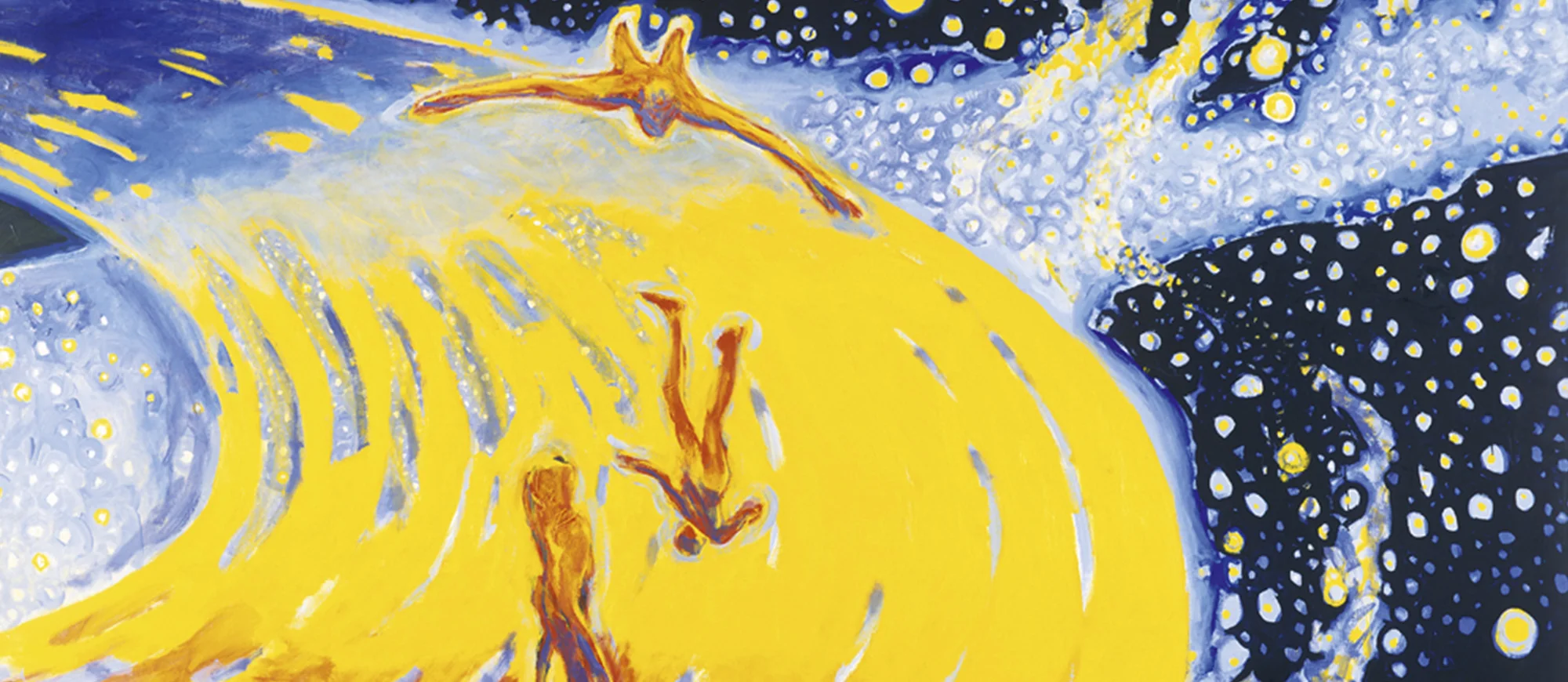FRANS WIDERBERG 1934 – 2017
Frans Widerberg, who died at his home in Oslo on April 7th, was arguably Norway’s most important figurative painter of the latter part of the 20th Century.
Born in Oslo in 1934 he escaped with his parents to Sweden during the Nazi occupation of Norway and after a series of studies, including a four month stint at Goldsmiths in London, spent three years at the National Academy of Fine Art in Oslo. There he studied painting under Professor Alexander Schulz but the moment of epiphany came to him when he received a state grant to travel to Italy. Disarmingly, he once remarked that until that point he had thought himself “fantastic” as an artist, but after encountering the giants of the Renaissance, notably Masaccio, he felt humbled and reduced to tears. Unsurprisingly, after early paintings which were relatively factual and sombre, he embarked upon the quasi-expressionist dramas by which he made his name.
For an English speaking audience he is best compared with Shakespeare’s Prospero, the magician who presided over the enchanted world of ‘The Tempest’. Widerberg’s virtual world is inhabited by winged dogs, tigers, floating figures, centaurs, human outcasts, the full repertory company of “such creatures as dreams are made on.” But, whereas Prospero’s island is largely benign, Widerberg’s setting is an existential wilderness illuminated by a light that sometimes recalls the Aurora Borealis and at others a post-nuclear incandescence. The dramas which take place in this neverland are sometimes affectionate (between man and woman, for instance) but at others, redolent of the untrammelled violence of Nils Gaup’s extraordinary film ‘Pathfinder’, based on a Sami legend. These encounters are not founded upon the Sagas, Wagnerian or any other existing legends but are allegories created by Widerberg himself. His homage to Masaccio’s ‘Expulsion’, for example, evokes the Holocaust just as much as it does the Fall.
The pictorial means by which this ‘shadow’ world was created consisted of a palette reduced to the three primaries of red, blue and yellow. Believing that light is created by colour, Widerberg typically established a blazing light, one which could set you alight, while irradiating a contingent space. “I provide myself with a pictorial universe where up is down and down is up: where far away is close and close is even closer – or farther away”, as he described it. A mercurial character, Widerberg loved paradoxes and inversions and, if one extends the Shakespearean analogy, frequently adopted the role of Feste, ‘the licensed fool’ of ‘Twelfth Night’ (“This fellow is wise enough to play the Fool. And to do that well craves a kind of wit”). Other formal devices included striated bands of colour that ultimately derived from the terraced hillsides of Liguria while the horse and rider motif, so redolent of Goethe’s poem ‘The Erl King’, doubtless originated in experiences in his childhood exile in Sweden.
He was the recipient of countless awards, representing Norway at the Venice Biennale of 1978, for example. That honour significantly demonstrated his independence of spirit. Never an issue based propagandist he nonetheless, as a confirmed pacifist, caused a major controversy in Washington DC in 1970 with his ‘Letters to America’ group of paintings, critical of the conduct of the Vietnam War, which were only shown at the Smithsonian after much protest. Perhaps a more telling example of his independence, resides in his refusal to conform to the orthodoxies of abstraction during the 60s and 70s, in order to pursue a resonant and poetic figuration.
Three years before his exhibition at the Venice Biennale, however, Robert Rosenblum published ‘Modern Painting and the Northern Romantic Tradition’, that cogent revision of the conventional account based upon Paris, (Impressionism, Cezanne, Cubism). Rosenblum posited an alternative narrative in which Caspar David Friedrich’s preoccupation with the infinite and the numinous led inexorably to Turner’s ‘pictures of nothing’ and Rothko’s transcendental mirages. He also dwelt upon that Dionysian aspect of Romanticism which is typified by philosopher poets such as Novalis, the painter of fantastic visions Runge, and even the Brothers Grimm. Coincidentally, Bruno Bettelheim’s great study of children’s fairy tales, ‘The uses of Enchantment’ was published at the same time. Bettelheim’s central premise was that fairy tales provide a psychological rehearsal for the strains and problems of adult life and one might reasonably claim that Widerberg’s imagery performs a similar function. These impulses, together with 1960s libertarianism and an interest in cosmology and science fiction, as well as Kirkegaard’s existential speculations, formed the conceptual matrix of Widerberg’s paranormal visions.
In his book, ‘As If’, published decades later and sub-titled ‘Modern Enchantment and the Literary Prehistory of Virtual Reality’, Michael Saler considered the persistent human appetite for wonders and marvels to the point where, beyond the “willing suspension of disbelief” the ironic imagination takes over; people would persuade themselves that something which is palpably fiction is actually real. In the early 20th Century, for example, many readers could not cope with Sherlock Holmes’ death at the Reichenbach Falls. Widerberg, with his metaphysical allegories may not quite elicit that response but, in an artistic milieu dominated by abstraction, he was vindicated, defiantly “re-enchanting a disenchanted world”. He leaves behind a wife, Aasa, and two sons, Nico and Thomas, both distinguished artists.
William Varley
SELECTED EXHIBITIONS
2015 University Gallery & Baring Wing, Newcastle upon Tyne
2014 Kings Place Gallery, London
2014 Kunstnerforbundet, Oslo
2012 Bærum Kunstforening, near Oslo
2012 Kunstverket Hovedøya Galleri, Oslo
2012 University Gallery & Baring Wing, Newcastle upon Tyne
2011 Aalesunds Kunstforening
2011 Galleri Fineart, Oslo


